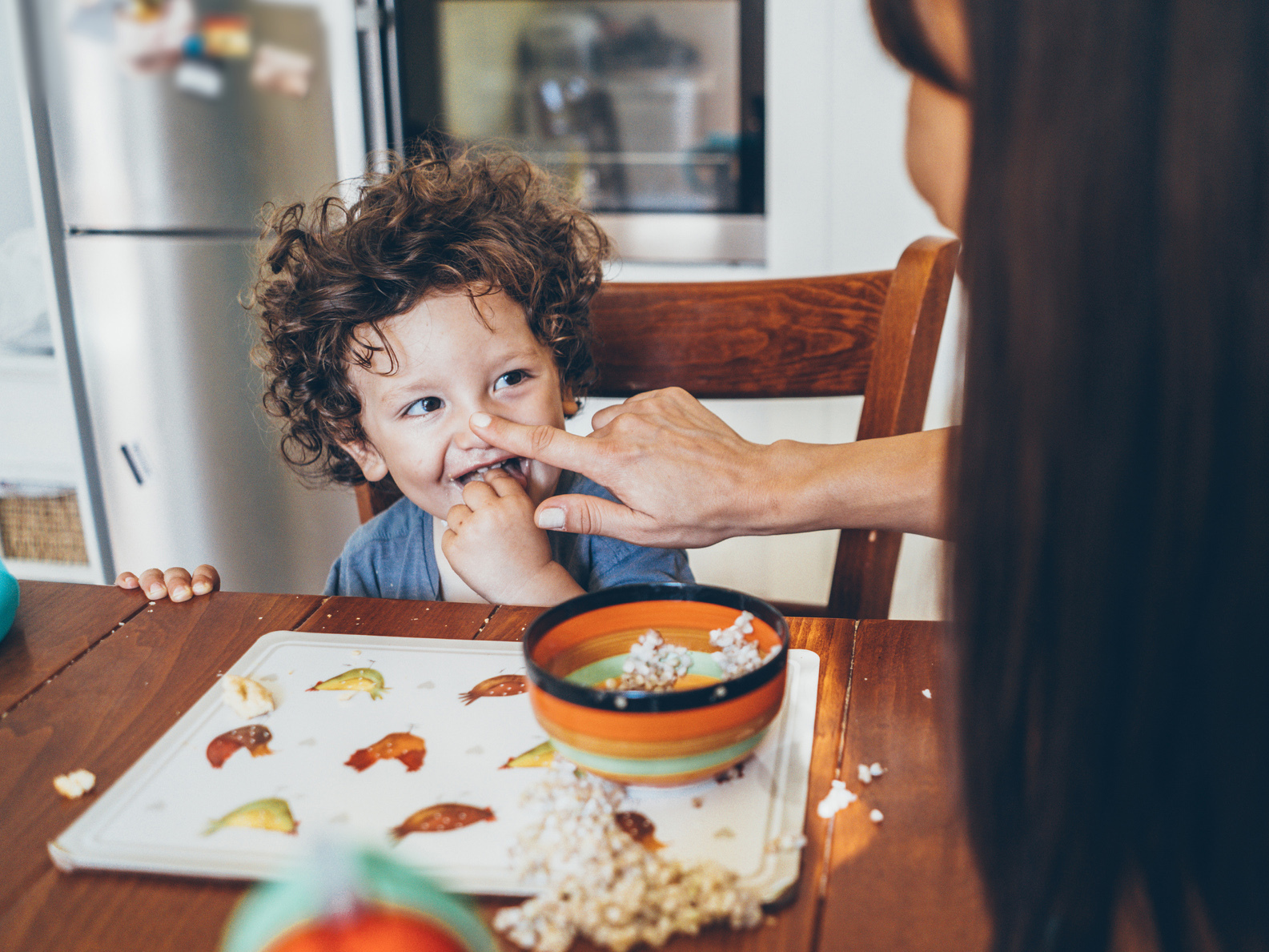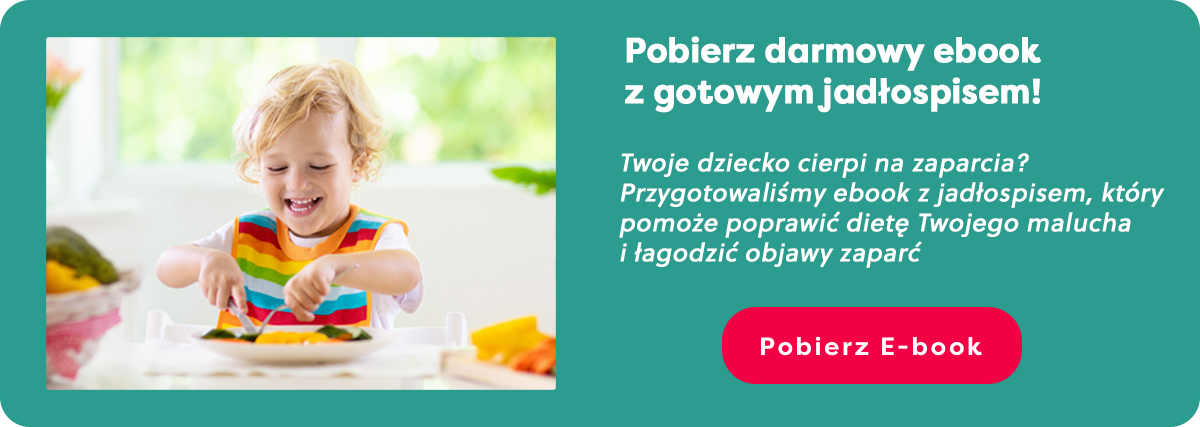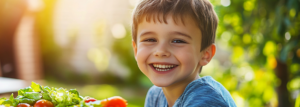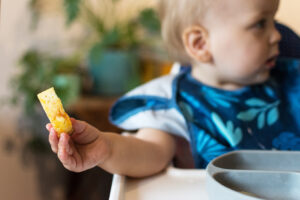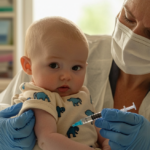Dieta bogatoresztkowa – sposób na zaparcia u dzieci
Spis treści:
Co to jest dieta bogatoresztkowa?
Dieta bogatoresztkowa nie ma nic wspólnego z resztkami kuchennymi. „Bogata w resztki” oznacza w rzeczywistości z dużą ilością niestrawnych elementów roślinnych, takich, których organizm dziecka nie potrafi przyswoić. Te niestrawne elementy to niejednorodna grupa związków nazywana błonnikiem pokarmowym, która, mimo że nie jest trawiona przez enzymy przewodu pokarmowego, to pełni bardzo ważne funkcje. Błonnik reguluje pracę jelit, zapobiega zaparciom, wpływa korzystnie na mikrobiotę jelit, zwiększa odczuwanie sytości po posiłkach, stabilizuje stężenie cukru we krwi.
Błonnik pokarmowy znajdziesz przede wszystkim w pełnoziarnistych produktach zbożowych oraz we wszystkich warzywach i owocach. Można przyjąć ogólne założenie, że nieprzetworzona lub przetworzona w niewielkim stopniu żywność roślinna = wysoka zawartość błonnika.
Błonnik pokarmowy najobficiej występuje w okrywach nasiennych zbóż i skórkach warzyw oraz owoców, bo z biologicznego punktu widzenia pełni on funkcję „rusztowania” dla rośliny, zapewnia jej kształt. To właśnie dlatego oczyszczona, biała mąka zawiera niewiele błonnika pokarmowego. Podobnie rzecz ma się z owocami – obrane, rozdrobnione, wyciśnięte mają mniejszą ilość błonnika.
Za dietę bogatoresztkową u dorosłych uważa się taki sposób żywienia, który dostarcza 40-60 g błonnika na dobę. Jednak dla dzieci tak duża ilość może być szkodliwa. Błonnik w niewielkim stopniu ogranicza wchłanianie z przewodu pokarmowego wapnia, żelaza i cynku. To trzy bardzo ważne z punktu widzenia rozwoju dziecka składniki mineralne. Z tego powodu dzieciom zaleca się spożycie błonnika pokarmowego na poziomie 0,5 g na każdy kilogram masy ciała.
Dieta bogatoresztkowa u dzieci nie jest zatem tą samą dietą bogatoresztkową, co u dorosłych. Warto o tym pamiętać, szukając przepisów czy informacji w Internecie. Klasycznej diety bogatoresztkowej dzieciom się w ogóle nie zaleca.
Na co pomaga dieta bogatoresztkowa?
Dieta bogatoresztkowa, a w zasadzie dieta z odpowiednią ilością błonnika pokarmowego, stosowana jest przede wszystkim u dzieci, które cierpią na zaparcia tzn. wypróżniają się rzadziej niż raz na 3 dni. Pamiętaj jednak, że ta ogólna norma dotycząca częstotliwości wypróżnień dla każdego dziecka może wyglądać inaczej. Są dzieci, które najlepiej czują się, gdy wypróżniają się raz dziennie, inne mogą korzystać z toalety 2 razy dziennie, a jeszcze inne raz na 2 dni. Obserwuj nie tylko częstotliwość wypróżnień, ale także (a w zasadzie przede wszystkim) samopoczucie swojego dziecka. Jeśli zmianie w wypróżnieniach towarzyszy ból brzucha, to warto zastanowić się, co dalej.
Dieta bogatoresztkowa jest stosunkowo prostą interwencją związaną wyłącznie ze zmianami w diecie, dlatego w przypadku zaparć warto zacząć właśnie od niej. Dzięki temu twoje dziecko uniknie przyjmowania leków i stresu z tym związanego. W jaki sposób dieta bogatoresztkowa pomaga na zaparcia?
Błonnik pokarmowy to grupa związków podzielona na dwie frakcje – błonnik rozpuszczalny w wodzie i błonnik nierozpuszczalny w wodzie. Ten pierwszy w przewodzie pokarmowym wchłania wodę i zamienia się w żel (trochę jak kleik z siemienia lnianego), osłaniając śluzówkę przewodu pokarmowego ochronnym filtrem. Błonnik rozpuszczalny rozluźnia masy kałowe i sprawia, że łatwiej je wydalić. Jednocześnie jest prebiotykiem, a mówiąc prościej, stanowi pokarm dla mikrobioty w jelicie grubym. Dzięki temu stabilizuje ją i wspiera wzrost korzystnych dla dziecka bakterii jelitowych.
Błonnik pokarmowy nierozpuszczalny w wodzie drażni jelita i przez to pobudza ich ruchomość (perystaltykę). Dzięki temu masy kałowe przesuwają się łatwiej. Ma on zdolność wiązania wody i zwiększania swojej objętości, co stabilizuje sytość po posiłku, ale też przyspiesza wypróżnienie.
Oba rodzaje błonnika występują w produktach roślinnych w różnych proporcjach, dlatego kluczem jest urozmaicenie diety.
Czy Twoje dziecko jest na diecie wegetariańskiej i zmaga się z zaparciami czynnościowymi? Nasz ebook może być dla Ciebie pomocny! Znajdziesz tam przepisy opracowane przez dietetyka klinicznego i dziecięcego, które zawierają odpowiednią ilość błonnika i płynów, dostosowaną do wieku dziecka. Pobierz poradnik i spraw, aby każdy posiłek był zdrowy i smaczny.
Co jeść na diecie bogatoresztkowej?
Zastanawiasz się, co powinno jeść dziecko na diecie bogatoresztkowej? Zobacz produkty, które są najbogatsze w błonnik pokarmowy:
- kasza gryczana,
- kasza jęczmienna,
- ryż brązowy,
- płatki owsiane,
- chleb żytni razowy,
- brukselka,
- kapusta,
- fasolka szparagowa,
- pietruszka,
- bakłażan,
- fasola biała,
- soczewica,
- siemię lniane,
- maliny,
- gruszki,
- jabłka,
- śliwki,
- morele,
- owoce suszone (ważne, by były niedosładzane!).
Postaraj się zacząć od wprowadzenia większej ilości warzyw do diety dziecka. Możesz przemycać je w postaci zmiksowanych sosów, kremowych zup czy past do pieczywa. Choć łatwiejsze zazwyczaj jest zwiększenie porcji owoców, to jednak nie powinno być to twoim pierwszym wyborem.
Dzieci instynktownie sięgają po słodkie produkty, a to może ich zniechęcać do dalszego eksperymentowania z warzywami. Z tego powodu najpierw warzywa, potem owoce – najlepiej w proporcji 1/4 owoców – 3/4 warzyw dziennie.
Nie rozpędzaj się z produktami pełnoziarnistymi. Nie wszystkie zboża w diecie dziecka muszą być pełnoziarniste, nie każda mąka razowa. Dlaczego? Z powodu utrudnionego wchłaniania składników mineralnych, czego przyczyną jest zbyt duża ilość błonnika.
U dzieci (nawet na diecie bogatoresztkowej) przyjmuje się, że produkty pełnoziarniste powinno się podawać w stosunku 1:1 z tymi z mąki oczyszczonej. W praktyce raz na śniadanie podasz dziecku bułkę kajzerkę, innym razem grahamkę. Raz do obiadu użyjecie kaszy jaglanej, innym razem gryczanej.
Z błonnikiem na zaparcia też można przesadzić! W takiej sytuacji u dziecka mogą pojawić się silne bóle brzucha i biegunki. Wystarczy, że przypomnisz sobie, co się dzieje, gdy zjesz za dużo fasoli. Właśnie o ten efekt chodzi! Ilość błonnika w diecie warto zwiększać stopniowo, bo przewód pokarmowy się do niego adaptuje.
Jak w prosty sposób zwiększyć ilość błonnika w diecie dziecka?
- do pulpetów mięsnych dodawaj gruboziarniste kasze,
- do smoothie owocowych dorzuć niewielką ilość szpinaku,
- zamiast masła do smarowania używaj pasztetów warzywnych na bazie strączków,
- naleśniki/placki/gofry przygotuj na bazie mąki pszennej białej z pełnoziarnistą wymieszanej 1:1,
- przemycaj warzywa w sosach, ale staraj się nie miksować ich na gładką masę za każdym razem,
- w ramach przekąski podsuwaj dziecku surowe owoce – mogą być pokrojone, ale ze skórką,
- jeśli twoje dziecko nie lubi pieczywa razowego, to kupuj graham, które jest lepiej akceptowane przez dzieci,
- do kanapki zawsze dokładaj minimum 2 gatunki warzyw,
- do dań na słodko możesz dodawać mus z suszonych śliwek,
- dania obiadowe posypuj niewielką ilością świeżo mielonego siemienia lnianego.

Polecamy
Domowe sposoby na zaparcia u dzieci
Im dziecko jest młodsze, tym trudniej rodzicom rozpoznać, z jakiego powodu jest niespokojne. Zaparcia, mogące pojawiać się już od pierwszych tygodni życia dziecka, są dla niego niezwykle dokuczliwe i nieprzyjemne. Budzą też niemały niepokój u rodziców. Czy zaparcia mogą być groźne? Kiedy iść do lekarza?
Dieta bogatoresztkowa – jadłospis
Zobacz przykładowy jadłospis diety bogatoresztkowej u dzieci. Pamiętaj, że ty decydujesz, co dziecko zjada, a dziecko decyduje, kiedy i ile zje.
Dzień 1.
Śniadanie: kasza jaglana na mleku 3,2 proc. ze świeżymi malinami i łyżeczką masła orzechowego.
Przekąska: koktajl z jogurtu naturalnego, banana, truskawek, siemienia lnianego i płatków owsianych.
Obiad: zupa pomidorowa z ryżem brązowym, grillowana pierś z indyka, surówka z białej kapusty i marchewki, ziemniaki gotowane posypane koperkiem.
Kolacja: kanapki z chleba graham z hummusem paprykowym i żółtym serem, pomidor i ogórek świeży do kanapek.
Dzień 2.
Śniadanie: naleśniki z mąki pszennej i pełnoziarnistej z białym serem i świeżymi brzoskwiniami.
Przekąska: porcja świeżych owoców.
Obiad: zupa kalafiorowa, pulpeciki z łososia z gotowaną fasolą szparagową i kaszą gryczaną.
Kolacja: jajecznica podawana z pomidorem i słupkami papryki, chleb pszenny pełnoziarnisty.
Dzień 3.
Śniadanie: bułka grahamka z masłem, pastą z makreli, ogórkiem zielonym i oliwkami.
Przekąska: bułeczka drożdżowa nadziewana jabłkami i suszonymi śliwkami.
Obiad: zupa z marchewki i soczewicy, makaron razowy z mielonym mięsem wołowym i pomidorami.
Kolacja: grzanki z chleba pszennego zwykłego z mozzarellą, pomidorami i bazylią.
Kiedy wprowadzić dietę bogatoresztkową?
O diecie bogatoresztkowej pisze się głównie w kontekście łagodzenia zaparć. Jednak o dietę z odpowiednią ilością błonnika u dziecka powinno się dbać już od początku rozszerzania diety niemowlęcia, by do zaparć w ogóle nie doprowadzić. Na menu najmłodszych warto zwrócić szczególną uwagę w momentach przełomowych, gdy dziecko zaczyna chodzić i gdy rozpoczyna przygodę przedszkolną. Wtedy zwiększa się samodzielność dzieci i, co za tym idzie, często zmienia się dieta, a to może przynieść niespodziewane problemy z wypróżnieniem. O odpowiednią ilość błonnika należy szczególnie dbać w czasie podróży.
Dieta bogatoresztkowa może też przynieść korzyści dzieciom, które odczuwają silny apetyt. Większa ilość błonnika pokarmowego zwiększa sytość i umożliwia odnalezienie właściwego rytmu posiłków.
Wprowadzenie diety bogatoresztkowej wiąże się ze zdrowszymi nawykami żywieniowymi i mniejszym ryzykiem chorób cywilizacyjnych w przyszłości dziecka. Nic jednak nie wydarzy się bez was drodzy rodzice, zmianę diety trzeba zacząć od siebie. Dzięki temu dieta bogatoresztkowa będzie naturalną konsekwencją domowej kuchni.
Źródła:
- Mirosław Jarosz i inni, „Normy żywienia dla populacji polskiej i ich zastosowanie”, Narodowy Instytut Zdrowia Publicznego – Państwowy Zakład Higieny, 2020.
- SwinneyBridget „Zdrowe jedzenie dla zdrowych dzieci”, Wydawnictwo Zielona Sowa.
- Zalecenia dotyczące żywienia dzieci zdrowych w wieku 1–3 lata (13–36 miesięcy), opracowane przez Zespół Ekspertów powołany przez Konsultanta Krajowego ds. Pediatrii, 2010.
- Merit M Tabbers, Marc A Benninga, Constipation in children: fibre and probiotics, BMJ Clin Evid. 2015 Mar 10;2015:0303.
- Renee Korczak i inni, Dietary fiber and digestive health in children, Nutr Rev. 2017 Apr 1;75(4):241-259. doi: 10.1093/nutrit/nuw068.
